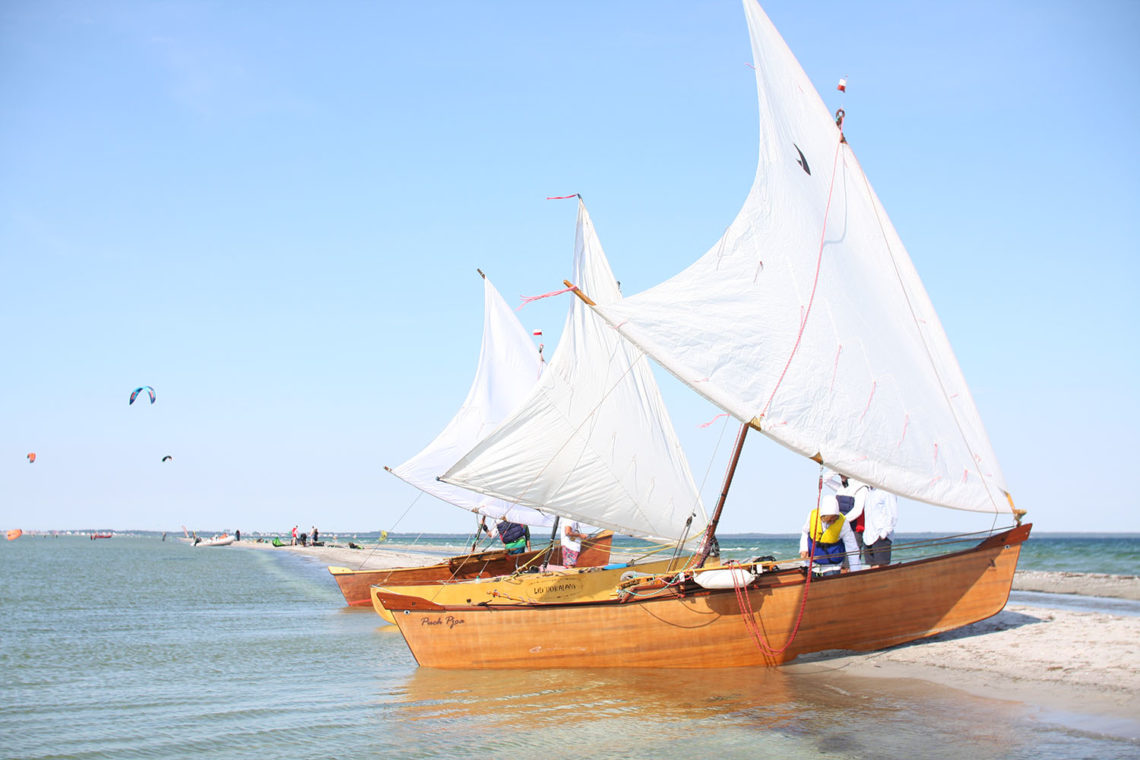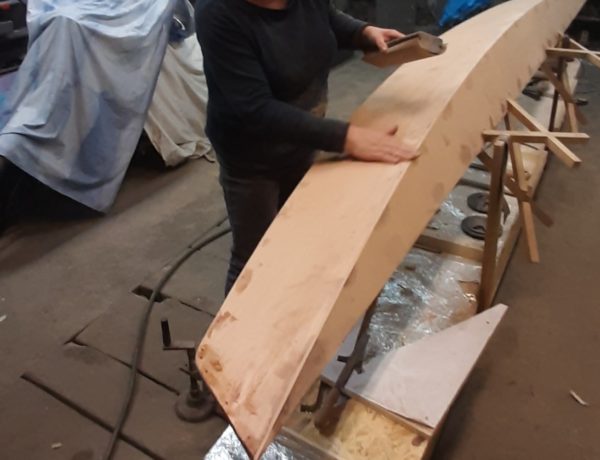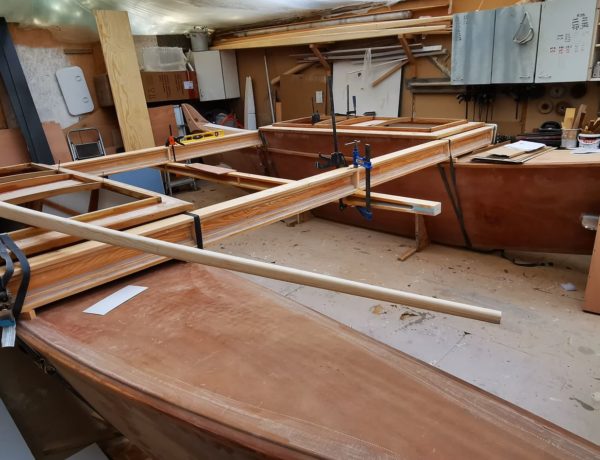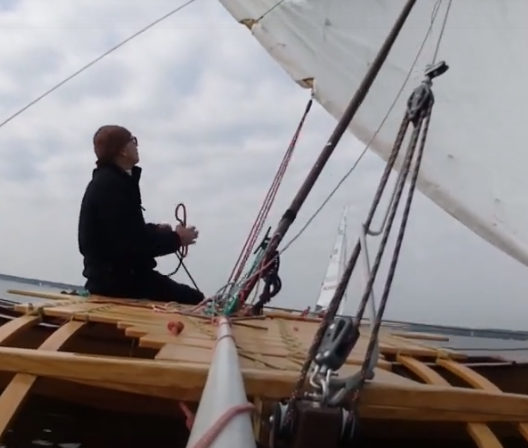In this article, I’m analyzing a few selected contours of a Crab Claws sail to determine what maximum surface area can be achieved for them, under the conditions that I consider necessary.
A proas of up to 7 meters length, usually needs as large sail area as possible, because we can manage counter ballasting aerodynamic forces in winds up to 3-4B. There are enough of little to moderate winds around here, so we can afford staying ashore in worse conditions.
Proa of this size simply needs as much power as possible, because the drag that has to be overcome will cannot be smaller then a certain value. Regardless of the size, proa needs crew on board. The minimum is one person, but for safety reasons, two should be considered. Whether we build a 3, 4, 5, 6 or 7 meter long boat, the required displacement of the boat will never go below 200kG, and most often it is well over 300kG (I don’t mean the boat’s weight, but the displacement needed not float with the crew on board). So when hull goes forward then 300kG of water has to be pushed aside so the hull can take this space. The slimmer the boat, the easier it is for the water to get out of way (wave and pressure resistance), and the shorter it is, the smaller the underwater area (the hemispherical bowl has the smallest) and therefore lower the friction.
First, I will discuss what common requirements I set for all the tested variants.
Condition 1:
In order for the mind to somehow embrace all the tiny forces acting on every inch of submerged skin, we replace them with one large force, hooked in one place. This place is located so that the total effect (magnitude of action, direction and rotational moment) are the same whatever approach we choose. The center of hydrodynamic forces determined in this way, in the side view, is usually slightly ahead of the center of the boat called the Center of Lateral Resistance [abbreviated as CLR], in the figure on the left marked with a white cross.


A similar, imaginary operation can be carried out for a sail whose resultant force is anchored in the Center of Effort (CoE). It is usually assumed that the CoE lies at the geometric center of the sail – I have marked it with a blue “X” in the picture to the right.
For proa to sail straight, the Center of Effort must be located precisely above Center of Lateral Resistance.
In the figure below, the CoE and CLR are connected by a thin, dashed, vertical line.
Thanks to such arrangement, the forces acting on the sail balance with those acting on the hull and, in the widest possible range of courses relative to the wind, there is no need to use the steering oar. Each engagement of the oar to steer is an additional increase in resistance and unnecessary physical and mental effort of the crew, and knocking the boat out of its natural behavior.
For the purposes of this analysis, I derive from this the condition that the theoretical center of the all variants lies at the same distance from the tack.
Condition 2:
If we want the sail to be as large as possible, we must use the entire length of the boat, so we place the tack as far forward as possible – at the very bow of the Vaka.
Condition 3:
In a natural way for shunting vessels, the sheet is attached to the hull in the middle of its length, and the attachment of the sheet to the boom will be located slightly above this place for practical reasons. We don’t want the boom colliding with the deck in case the rigging bends under load, and we also need some space for blocks which reduce the forces in the hand holding the sheet.
For the purposes of this analysis, I assume for all variants that the boom passes through exactly the same point in space where I would attach the sheet to it. In the picture above it is a red rhombus on the lower edge of the sail.
Condition 4:
We cut the crab claws sail as completely flat. The yard needs to be tilted backwards so that after a slight lift of the boom, a beautiful aerodynamic profile will be obtained under the wind pressure.
The place where the halyard is tied to the yard in the Pjoa boat family follows original designs from the Marshall Islands. After many calculations of the strength of the spars, changing stiffness along the tapered spar and how they deform under load, I obtained very similar results to those observed in old photos from Oceania, so now I know what is the reason for this and I can determine the best place for the halyard on the spar to the nearest centimeter .
The yard is fixed with halyard just at the masttop. During shunt this point is being moved towards the new bow. The kinematics of the rigging during this maneuver locates the connection of the mast with the yard on above the point almost in ¼ of the length of the hull, only slightly closer to the bow.
I decided that, for the purposes of this comparison, the yard of all variants passes through the same place, marked in the drawing as no. 4.
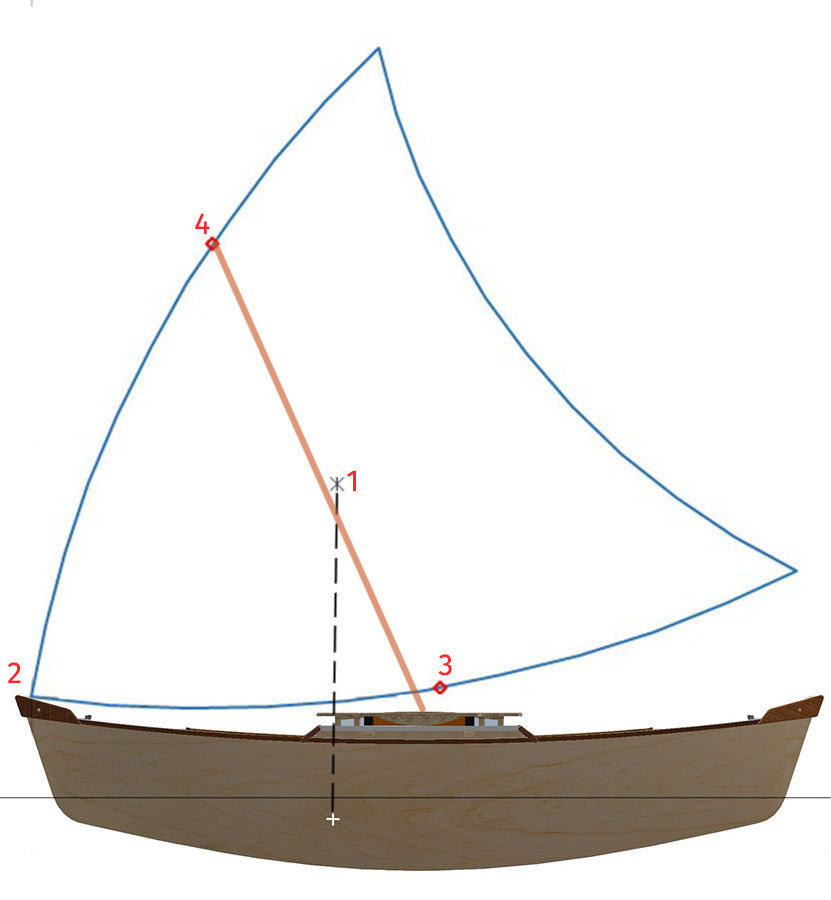
Conclusion 1:
Now we can draw several sails with typical contours of Crab Claws, each of which fulfills the same conditions specified above.
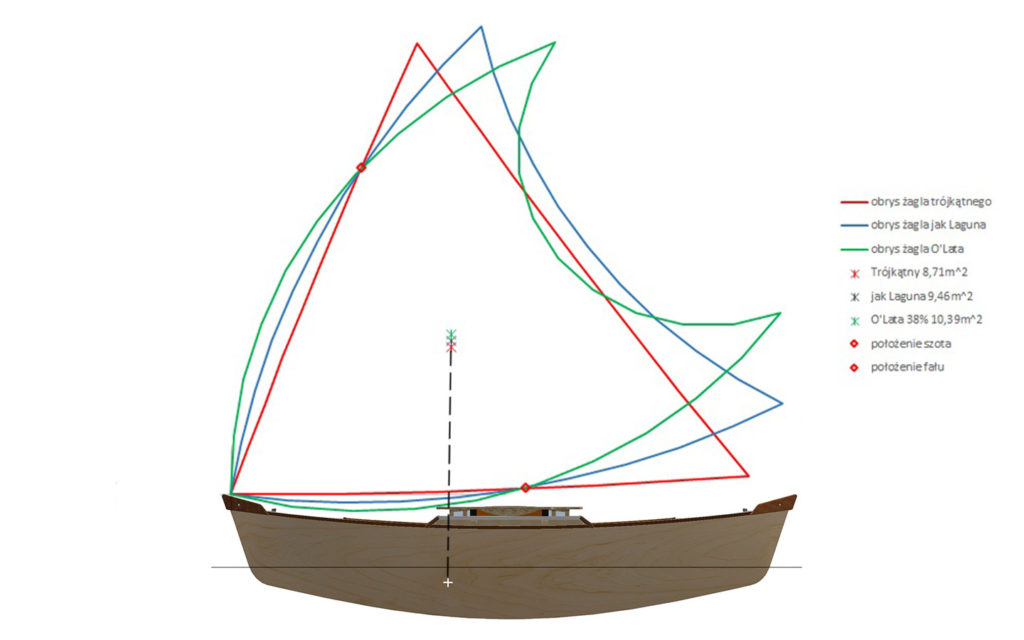
We have designed Pjoa Folk as the easiest to build, therefore he can be first choice of newbies. The simplest spars are completely straight ones and the simples sail fitting to them, has a triangular contour. I have marked this variant with a red line in the picture above. It seems a good choice for a novice proanaut because this one has the smallest surface area and the lowest lying Center of Effort of all the shapes studied.
As a basic sail shape within Pjoa family, I have designed Crab Claws with canvas stretched between stiff spars with moderate curvature built in and a slightly concave leech. In the drawing I show such contour drawn with a blue line. For a 5 meter long proa, the center of this sail is 6 cm higher than for the triangular sail, and it’s surface area is bigger by 108.7% compared to the triangular.
I’ve started recently a research on the aeroelasticity of a sail with a shape similar to O’Lata from the Santa Cruz Islands (marked in green in the picture), which is set with much lighter and very flexible spars. Perhaps it will turn out to be a good idea for Junior Pjoa project intended for youth, so I included it’s contour to the comparison. With a standard vaka length of 5 meters, the center of this sail is 12 cm higher than for the triangular sail, but it is even larger and its surface area is 119.3% of the triangular version. This is almost 1/5 more(!) of power, which is priceless in light winds.
Conclusion 2:
I was also interested in the leech’s concave influence on the surface area of the Crab Claws.
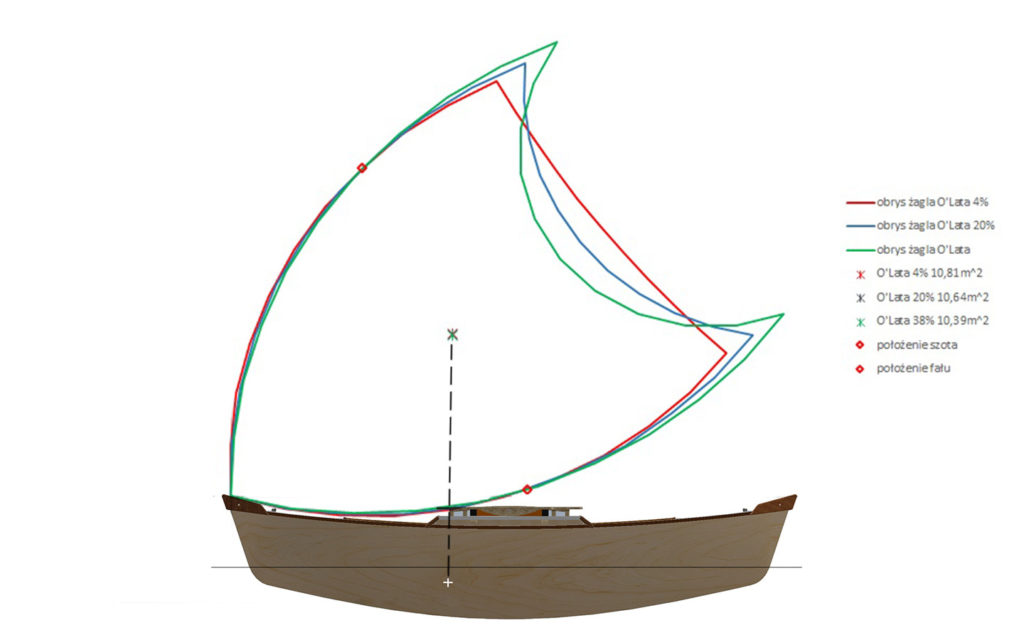
There is probably no surprise in the fact that the height at which the Center of Effort is, practically does not change.
A sail with a straight leech was taken as the basis for comparisons.
If I apply slight concavity of the leech, comparable as we use for Pjoa Laguna, then it reduces the surface area to 98.5%.
A sail with the significantly deeper leech (38% of the chord) has the surface area reduced to 96.1%.
I conclude then, that the concave of the leech could be rewarding in regards to the power obtained, provided that we obtain such an improvement in profile quality that it will compensate for the reduction in area by 1.5% and 3.9%, respectively
Sails with spars and the leech curved so much as in this (green) example were developed in the Santa Cruz Islands, and similar sails are hoisted on double pirogues around Papua New Guinea. Winds which dominate on the waters around these places are mostly light. Huge sails are needed. Spars weight on large TePuke can be a huge problem then. Genius Polynesian innovators had found other way to keep sail stable then applying very rigid but also very heavy poles. After all, the point is only that the fabric of the sail cannot “pull” the yard or boom inwards. The desired effect can be obtained, if the taken straight, thin beam is strongly bent from the very beginning thru the whole range of wind conditions. Prestressing yards in no-wind is possible thanks to special shape and sailcut of the O’Lata sail. A huge concave of the leech helps the weft to keep spars bent even in the lightest conditions. This choice gives also a number of other unusual and interesting effects, which I would strongly encourage everyone to search, observe and share :).
Stare Załubice, November 2022.

